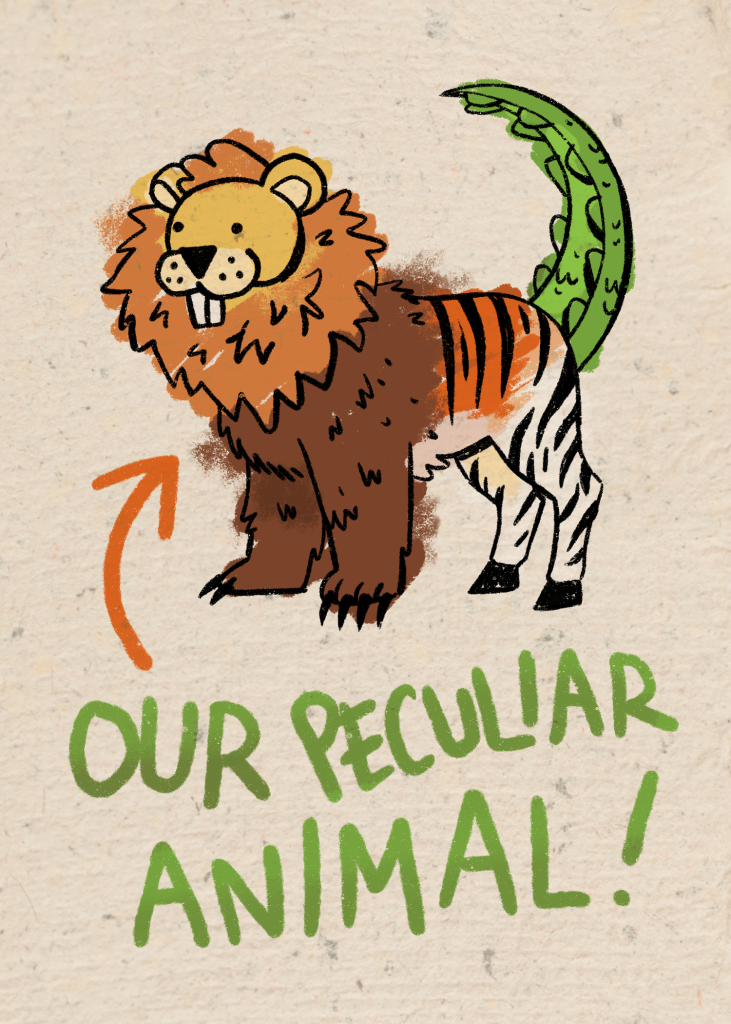Students learn about animal adaptations and design their own peculiar animal. Next, they talk about the impacts humans can have on animals and what we can do to protect them.

Grade level: K-3, 4-6
Learning Objectives:
– Understand why and how animals adapt to their environment
– Identify ways to reduce our impact on wildlife
During this activity, students will:
– Consider how animal adaptations help them survive
– Create an animal taking into account different criteria
– Describe ways our actions harm animals and suggest what can be changed
Materials:
• Animal Environment cards, one per group
• Our Peculiar Animal Handout or a piece of paper, one per group
• Drawing materials
Set up:
Before beginning:
1. Prepare cards, handouts, and drawing materials
2. Decide how to break up the class into groups
3. Decide how much time the students will have to draw (we suggest 15-20 minutes)
Instructions
- Ask students the following questions to activate previous knowledge:
•What allows fish to survive underwater?
•What allows polar bears to survive in the artic?
•What allows reptiles to survive in the desert?
2. Explain that these are called adaptations, and that there are many ways that animals adapt which help them survive, acquire food, avoid predation, etc.
The following videos can be used to review animal adaptions:
Explore animal adaptations (8:21, Smithsonian, National Museum of Natural History)
What are animal adaptations? (3:31, LaFountaine of Knowledge
Together, list different ways animals adapt and why they are important, for example:
• Types of Body Covering– Fur, feathers, scales
• Colours– Patterns, camouflage – a color or pattern that allows an animal to hide in its environment
• Body Parts– Claws, beak, antlers, ears, webbed feet, specialized teeth, different types of vision, blubber (to keep them warm)
• Defenses– Spray, quills, venom
3. Explain the activity:
Today, in small groups, you will be designing your own animal! Each group will receive a card with information about where your animal lives, what your animal eats, and your animal’s predators.
Together, you will design an animal that is adapted to this environment, draw it and give it a name.
4. Split the students into groups and distribute the cards. If needed, help the groups read and understand the cards.
5. Have the students draw during the allotted time. Encourage creativity and cooperation.
Discussion
Once the time is up, each group shares their animal with the class and explains how their animal would survive in its environment. If several groups have the same environment, you can ask them to present their animals at the same time. Next, discuss the following questions:
1. What would happen if your animal can no longer find its food?
2. What might hunt your animal? What would happen if your animal’s predator disappears?
3. How might humans negatively affect your animal?
4. How could you help protect your animal?
Below are some suggested questions for each environment:
Frostyland: What would happen if the polar bears learned how to swim?
Foggy Jungle: What would happen if there was no more fog?
Forever Night Desert: What would happen if it rained and the desert flooded?
Downpour Rainforest: What would happen if it only rained a few times a year and most of the water on the forest floor disappeared?
Twin Islands: What would happen if the water level rose and the beach washed away?
Coral Reef: What would happen if the ocean temperature got too hot and the coral reefs and fish died?
Going further:
1. How do we negatively affect animals in the real world? (For example: Building roads, putting pollution in the air, leaving out garbage that animals eat, etc.)
2. What can we do to protect animals?
Extension Activity: Create a mini “Peculiar Zoo” in your classroom by displaying students drawing along with brief descriptions of the animals’ adaptaions.
Resources
Videos:
Explore animal adaptations (8:21, Smithsonian, National Museum of Natural History)
What are animal adaptations? (3:31, LaFountaine of Knowledge)
Books (Grades 1-3):
How Do Animals Adapt? by Bobbie Kalman (2000, Crabtree Publishing)
Animal Adaptations by Julie Lundgren (2011, Carson Dellosa)
